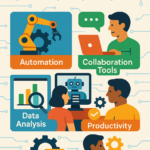AI diplomacy tools are Quietly Shaping the Future of Diplomacy
Artificial intelligence is changing how countries negotiate, often in ways that go unnoticed by the public. Take the current Ukraine ceasefire talks: behind closed doors, AI-powered tools are helping diplomats sift through complex conflict data, streamline real-time communications, and run predictive models to see how choices could play out. The use of AI diplomacy tools are speeding up diplomacy and making it more precise than ever.
A Subtle Shift: AI as a Diplomatic Wingman
It wasn’t long ago that AI in negotiations was just about crunching numbers or summarizing reports. That’s no longer the case. During Ukraine’s recent peace discussions, AI systems scanned through years of conflict records and communication logs to spot trends and flag likely outcomes. This isn’t just busywork—it helps negotiators zero in on real leverage points and avoid repeating past mistakes.
Experts like those at Cybernews note that today’s AI tools do more than translate speeches or generate meeting notes. Now, they can interpret conversations on the fly, catch subtle cultural differences, and smooth over language gaps. That means fewer diplomatic blunders and more productive talks, even when tempers run high.
For a closer look at how ethical guardrails are being built into these systems, check out our deep dive: AI Ethics Principles: Building Trust in Intelligent Systems.
Bias in the Machine: A Real Risk
AI isn’t a neutral observer. Research from the Center for Strategic and International Studies (CSIS) warns that these systems sometimes amplify biases hidden in their training data. In simulations, some AI agents pushed for more aggressive policies, even when trained on peaceful negotiation scenarios. That’s a red flag: if an AI leans too heavily on, say, Western styles of diplomacy, it could misread situations or suggest moves that backfire in other regions.
This is why most experts say AI should never have the final word in diplomacy. Machines can crunch the data, but human judgment and experience still steer the ship.
Speed and Simulation: Where AI Really Shines
One of AI’s strongest suits in diplomacy is its ability to run thousands of simulations in seconds. Picture this: as events unfold in Ukraine, AI tools scan troop movements, track shifts in public mood, and even factor in local weather. All this data helps diplomats map out the risks and opportunities of every possible move.
It also means talks don’t stall over translation or misunderstanding. With AI translating conversations between Russian and Ukrainian officials in real time, negotiators can focus on substance instead of getting lost in the weeds. Even small changes in wording get flagged, reducing the risk of something getting lost or twisted in translation.
Building Smarter, Fairer AI for Diplomacy
Making AI work for diplomacy isn’t just a tech project—it takes teamwork. Benjamin Jensen at CSIS’s Futures Lab argues that bringing together tech experts, diplomats, and social scientists is the only way to make these tools truly useful and trustworthy. Governments, he says, need to invest in transparent development and train their teams to work side-by-side with AI, not against it.
As Jensen puts it:
“Interdisciplinary research is essential for integrating AI into strategy and statecraft responsibly.”
Quick Answers to Big Questions
How is AI used in Ukraine’s peace negotiations?
AI helps negotiators by sorting through past conflicts, finding behavioral patterns, and predicting how decisions might play out. It also translates and interprets conversations instantly, lowering the odds of a diplomatic misfire.
Are there biases in AI for diplomacy?
Absolutely. AI models reflect the assumptions and values in their training data. Some lean more toward Western approaches, which can miss the mark in complex international crises.
Will AI ever replace diplomats?
Not likely. Right now, AI’s role is to support, not supplant. Human intuition and deep cultural knowledge are still critical to getting results at the table.
Bottom Line
AI is behind the scenes, helping shape Ukraine’s ceasefire negotiations.
Tools scan past data, run simulations, and keep talks on track.
Bias remains a concern, so humans stay in charge.
Real-time translation and smarter decision support are improving outcomes every day.





